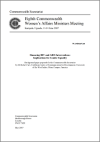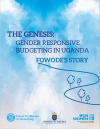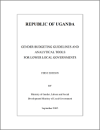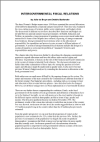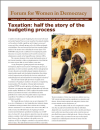FOUND 12
The publication is comprehensive review of ACFODE of Uganda's gender budgeting experiences at the local level. Among some of the topics discussed in the newsletter are ACFODE's initiatives, mission, activities, lessons learnt, local level gender budget research and more.
Background paper prepared in May 2007 for the Commonwealth Secretariat by Dr Robert Carr, Caribbean Centre of Communication for Development, University of the West Indies, Mona Campus, Jamaica Commonwealth Secretariat.
Story portraying the importance of gender responsive budgeting (GRB) and the activism for the advancement of women in decision-making and leadership by the Forum for Women in Democracy (FOWODE) in Uganda.
This background paper was prepared for the Commonwealth Secretariat in May 2007 by Mariama Williams, Adjunct Associate, Center of Concern, Washington DC and Research Adviser for the International Gender and Trade Network.
The Gender Budgeting guidelines have been developed to address the current deficiencies in gender budgeting. They aim to provide LLG stakeholders with a systematic way of developing budgets that address the need of females and males equitably.
This document, represents the gender analysis that was conducted on Tanzania's 2003-2004 National Budget.
The gender budgeting guidelines for girls' education were developed by the Ethiopian Minsitry of Finance and Ministry of Education in 2009 to provide guidance to planners and budget experts in their decision making in resource allocation to achieve girls' equal access to education at all levels.
This study "Intergovernmental Fiscal Relations" by Debbie Budlender and Julia de Bruyn, based on the South African case, discusses the allocation of responsibility for expenditure and powers to raise revenue to different spheres of government.
The document by Forum for Women in Democracy (FOWODE), is a brief paper on the gender analysis of the Uganda taxation sector.
This report presents research on the costs of implementing South Africa's Domestic Violence Act (DVA), with a focus on quantifying missing personnel costs. It describes the methodology used in the research, the process required to obtain a protection order and the time taken at each step.

